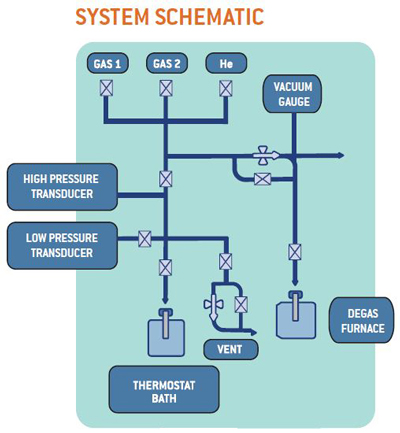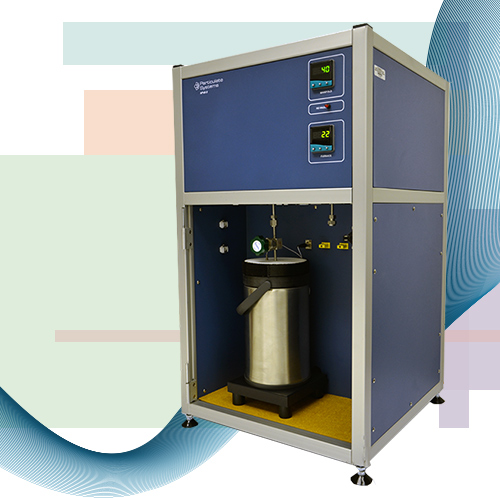HPVA II - High pressure Volumetric Analyzer
High Pressure Specialty Applications:
The HPVA II Series of adsorption analyzers from Particulate Systems uses the static volumetric method to obtain high-pressure adsorption and desorption isotherms utilizing gases such as hydrogen, methane, and carbon dioxide.
The volumetric technique consists of introducing (dosing) a known amount of gas (adsorptive) into the chamber containing the sample to be analyzed. When the sample reaches equilibrium with the adsorbate gas, the final equilibrium pressure is recorded. These data are then used to calculate the quantity of gas adsorbed by the sample.
This process is repeated at given pressure intervals until the maximum preselected pressure is reached. Then the pressure can be decreased to provide a desorption isotherm. Each of the resulting equilibrium points (volume adsorbed and equilibrium pressure) is plotted to provide an isotherm.
Excellent reproducibility and accuracy are obtained by using separate transducers for monitoring low and high pressures.
Features:
- Wide Operating Pressure range: High Vacuum to 100 or 200 bar
- Broad Temperature Capability: From cryogenic to 500 °C
- Excellent control of sample temperature by means of a recirculating temperature bath, cryogen dewar, or furnace
- Manifold temperature controlled with heater for stability and accuracy
- Fully automated analysis using interactive software
- Excellent data reproducibility
- Handles typical adsorbates such as nitrogen, hydrogen, methane, argon, oxygen, and carbon dioxide
- Comprehensive Data Analysis package using Microsoft Excel macros for data processing and graphing
- Software includes NIST REFPROP
Benefits:
✔ Dual free-space measurement for accurate isotherm data
✔Free space can be measured or entered
✔ Correction for non-ideality of analysis gas using NIST REFPROP compressibility factors calculated from multiple equations of state
✔ Reports provided as interactive spreadsheets
✔ Isotherm and weight percentage plots created automatically
✔ Real-time charts for Pressure vs. Time and Temperature vs. Time
✔ Gas mixtures with up to three components can be used
✔ Kinetic data provided for rate of adsorpotion calculations
✔ Langmuir equation used to model Type I isotherms
✔ High-precision, solid-state design high-pressure transducer provides a reading accuracy of ±0.04% full scale with a stablility of ±0.1%
✔ System can attain a maximum pressure of 200 bar
✔ Hydrogen gas sensor automatically shuts down the system should a hydrogen leak occur
✔ BET surface area, Langmuir surface area, and total pore volume calculations included
System Overview
Four Methods of Sample Temperature Control
Refrigerated/heated recirculation vessel (customer provides temperature control bath)
Four-liter, stainless-steel dewar for liquid cryogen
Furnance allows for experiments ranging up to 500 °C
Cryostat can precisely control sample temperatures from ambient conditions to 30 K
HPVA II system overview diagram
Manifold
All the valves in the manifold are pneumatically operated, high-pressure valves with Kel-F® seats. Valve tubing is constructed with heavy wall, 316L stainless steel and is attached via a VCR connection or welded. The temperature of the insulated manifold region is stabilized using a heater controlled by an adjustable PID controller.
Pressure Transducers
Two transducers are used to precisely measure the system pressure. A 1000- torr transducer is used to accurately monitor pressures below 1 atmosphere and is protected from high pressure with an isolation valve and a cracking valve that relieve to the vent.
Servo Valves
The servo valves are used to automatically regulate flow of the gas in the manifold to the vent and vacuum. Servo Valves The servo valves are used to automatically regulate flow of the gas in the manifold to the vent and vacuum.
Vacuum Systems
Consists of a mechanical pump and internal Pirani vacuum gauge. User can provide their own pump or purchase the high-vacuum turbo pump package.







